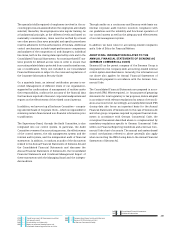Siemens 2014 Annual Report Download - page 232
Download and view the complete annual report
Please find page 232 of the 2014 Siemens annual report below. You can navigate through the pages in the report by either clicking on the pages listed below, or by using the keyword search tool below to find specific information within the annual report.
108 A. To our Shareholders 131 B. Corporate Governance 171 C. Combined Management Report
172 C. Business and economic environment
187 C. Financial performance system
193 C. Results of operations
205 C. Financial position
210 C. Net assets position
affected by regulations and policies related to energy and the
environment. Healthcare is dependent on policy development
and regulations affecting healthcare systems around the world,
particularly in the important U.S. healthcare market. Our for-
mer Industry Sector is vulnerable to unfavorable market condi-
tions in certain segments of the automotive and manufac-
turing industries. Our former Infrastructure & Cities Sector
focuses, among other things, on business with public authori-
ties around the world and is thus vulnerable to restrictions in
public budgets.
Our business, financial condition and results of operations
may be adversely affected by continued strategic alignments
and cost-cutting initiatives: We are in a continuous process of
strategic alignments and constantly engage in cost-cutting
initiatives, including ongoing capacity adjustment measures
and structural initiatives. Capacity adjustments through
consolidation of business activities and manufacturing facili-
ties, and the streamlining of product portfolios are also part of
these cost reduction efforts. These measures may not be imple-
mented as planned, may turn out to be less effective than an-
ticipated, may become effective later than estimated or may
not become effective at all. Each of these factors alone or in
combination may negatively impact our business, financial
condition, and results of operations. Any future contribution of
these measures to our profitability will be influenced by the
actual savings achieved and by our ability to sustain them.
Our businesses must keep pace with technological
changes and develop new products and services to remain
competitive: The markets in which our businesses operate ex-
perience rapid and significant changes due to the introduction
of innovative technologies. To meet our customers’ needs, we
must continuously design new products and services and up-
date existing ones, while investing in and developing new
technologies. Introducing new products and technologies
requires a significant commitment to research and develop-
ment, which in return requires expenditure of considerable
financial resources that may not always result in success. Our
sales and profitability may suffer if we invest in technologies
that do not operate or may not be integrated as expected, or
that are not accepted in the market place as anticipated, or if
our products or systems are not introduced to the market in a
timely manner, particularly compared to our competitors, or
become obsolete. We constantly apply for new patents and
actively manage our intellectual property portfolio to secure
our technological position. However, our patents and other
intellectual property may not prevent competitors from inde-
pendently developing or selling products and services that are
similar to or duplicates of ours. There can be no assurance that
the resources we invest to protect our intellectual property
will be sufficient or that our intellectual property portfolio will
adequately deter misappropriation or improper use of our
technology. Furthermore, in some of our markets, the need to
develop and introduce new products rapidly in order to cap-
ture available opportunities may lead to quality problems. Our
operating results depend to a significant extent on our ability
to anticipate and adapt to changes in our markets and to
reduce the costs of producing high-quality products. Among
recent technology trends, we are carefully evaluating the
potential and relevance of digitalization. We believe that the
potential and usage scenarios of this technology vary among
our products, solutions and services depending on the degree
of information technology utilized. However, we also believe
that this trend needs to be monitored closely, because it might
bear the potential to change the competitive landscape. Any
inability to adapt to the aforementioned factors could have an
adverse effect on our business, financial condition and results
of operations.
Our business, financial condition and results of operations
may be adversely affected by portfolio measures: Our strat-
egy includes divesting activities in some business areas and
strengthening others through portfolio measures, including
mergers and acquisitions.
With respect to divestments, we may not be able to divest some
of our activities as planned, and the divestitures we do carry
out could have a negative impact on our business, financial
condition, results of operations and our reputation. As a major
divestment, we agreed that Bosch will acquire Siemens’ stake
in BSH Bosch und Siemens Hausgeräte GmbH.
Mergers and acquisitions are inherently risky because of diffi-
culties that may arise when integrating people, operations,
technologies and products. There can be no assurance that any
of the businesses we acquire can be integrated successfully and
as timely as originally planned, or that they will perform as
anticipated once integrated. In addition, we may incur signifi-
cant acquisition, administrative and other costs in connection
with these transactions, including costs related to integration
of acquired businesses. For example, in September , we
entered into an agreement with Dresser-Rand to acquire all of
its issued and outstanding common shares by way of a friendly
takeover bid. At the beginning of May , we announced the
acquisition of the Rolls-Royce Energy aero-derivative gas
turbine and compressor business of Rolls-Royce plc, U.K. (Rolls-
Royce). Furthermore, portfolio measures may result in addi-
tional financing needs and adversely affect our financial
leverage and our debt-to-equity ratio. Acquisitions may also
lead to substantial increases in intangible assets, including
goodwill. Our Statements of Financial Position reflect a signifi-
cant amount of intangible assets, including goodwill. Among
our businesses, the largest amount of goodwill is allocated to
























